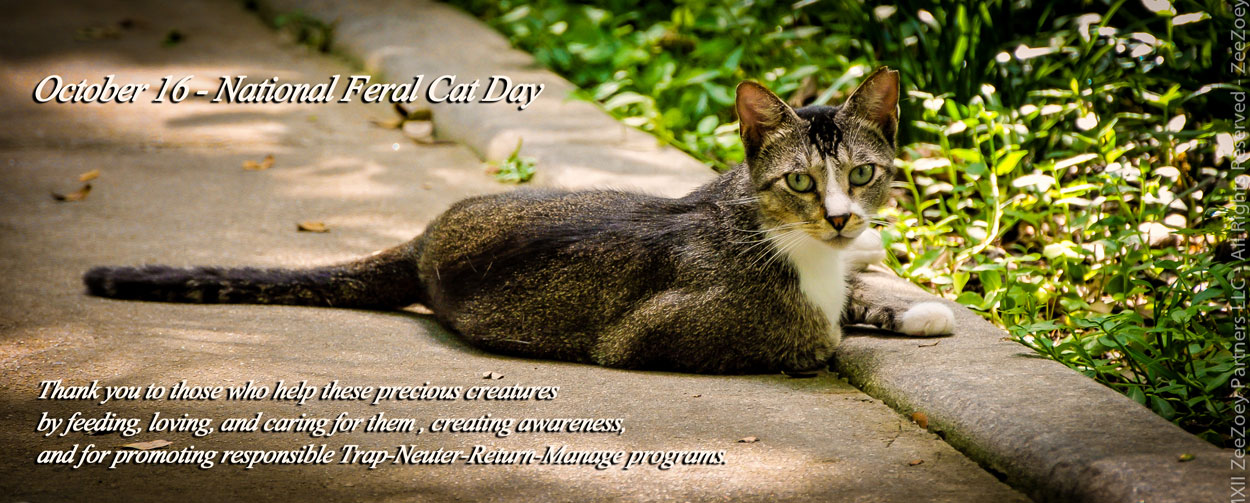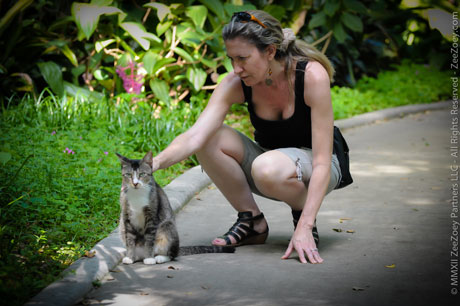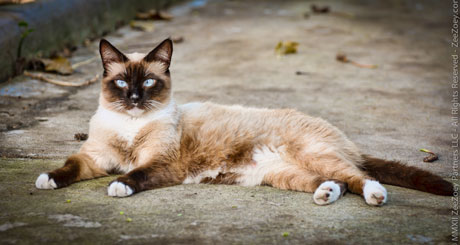National Feral Cat Day and Raising Awareness About Community Cats

Feral cats have different degrees of human tolerance – this beautiful boy with his left ear clipped (a universal sign he has been altered) lives at Flamingo Gardens in S. Florida and is part of a well managed outdoor cat community on the premises. He stays in the background and runs if you get too close to him. He does not want to hurt anyone and just wants to be treated with respect. Click image to enlarge.
Years ago I never knew this, but cats were living outside all around me in places like abandoned buildings, empty parking lots, parks, alley ways, retail establishments, rural, city, and suburban neighborhoods and just about anywhere that offered shelter and a food source for them that you could think of. I have since learned that these cats are called ferals, a cat that has primarily only known a life outdoors with little to no human contact.
Now that they have become more of a mainstream topic, the preferred term for them is outdoor community cats – the collective outdoor cats that live within the fabric of our society due to a variety of circumstances. Some cats are feral by birth and are extremely cautious and fearful of human contact, some are semi-feral in that they can build a trust with people who take it upon themselves to feed them on a daily basis, and some are stray cats that might have had a home at one point or another and now find themselves outdoors, either through deliberate circumstances whereby a pet guardian may have abandoned them or through accidental circumstances such as being lost.

This darling girl is also part of the Flamingo Garden community – she is semi-feral and she trusted me enough to let me pet her. She is happy and healthy and because she is spayed, there will be no worries of her adding to the cat population.
Regardless of the circumstances, these outdoor cats are often misunderstood as being dangerous, filthy, disease ridden creatures that are a menace to our society and that is why today, National Feral Cat Day, is so important because it gives us an opportunity to use the day to create nationwide awareness that these cats can actually peacefully co-exist within our communities with proper management and that the only real viable way to keep their populations from escalating is to promote affordable spay/neuter options and to provide information to the public at large about these cats that is easy to understand. To aid in that aspect, I have put together a very simple list of the 101’s of outdoor community cats so that people can arm themselves with information. Knowledge is power and it is the first step to positive change:
1. Even if you don’t have a cat, or don’t like cats, by virtue of living in a community it should be your civic duty to be responsible. Stray and feral cats roaming the streets will procreate and the cat overpopulation will continue to escalate unless TNRM (Trap-Neuter-Return-Manage) programs are instituted (it is estimated by the ASPCA that we have an overpopulation epidemic of upward of 70 million stray and feral cats in the United States). Support your community shelters, either by donations, volunteering, or by understanding how important it is for these programs to be put in place and managed. If you chose to turn your head and have the attitude that it is not your problem, nothing will be solved.
2. Feral cats are not dangerous and do not attack people. While they may become familiar with a caretaker, these cats tend to avoid humans and usually only come out at night.
3. It is not cruel for a feral cat to live outdoors. Because they are not socialized to humans or indoor settings, they are typically unable to cope and do not adjust to the confinement or human contact. In fact, it can actually be detrimental to the cat to try to tame and socialize it. A feral cat may exhibit adverse behavioral problems in an indoor setting that are insurmountable to change, which often results in the cat being unfairly brought to a shelter where they are labeled “unadoptable” with an almost certain consequence of euthanization (according to Alley Cat Allies, almost 100% of feral cats brought to shelters are euthanized).
4. Feral cats are not responsible for the depletion of wildlife. In reality that is caused by urbanization, global warming, pollution, and construction. A managed feral colony is actually well fed and does not have a need to excessively hunt for food.
5. TNRM works and is the safest and most beneficial program available to both the feral cat and the community. The colony’s population decreases (and stabilizes) and the negative behaviors associated with cats such as spraying and noises from mating and aggressive fighting is significantly reduced.
6. You can identify a cat that has already been part of the TNRM program by the universal practice of clipping the tip of the left ear of the cat.
7. If you do not know how to properly trap a cat or don’t have a trap, this should not dissuade you from helping. Contact your local shelters for assistance, or call a national organization like Alley Cat Allies for advice. Typically they will send someone out to help so that the cat is trapped in a humane manner and can be spayed or neutered, ear tipped, and then released back into the colony after it recovers from surgery.
8. Feral cats are not a filthy and disease ridden creature. In actuality, feral cats have a low rate of diseases and live a long and healthy life. This is particularly true because the feral cats that have been spayed or neutered are also vaccinated.
9. Cats can reproduce at an alarming rate when not managed. An unspayed/neutered cat pair leads up to 5,000 cats in 7 years. Because only 2% of feral cats are sterilized, there is an enormous need to institute proper TNRM programs within a community. Most communities offer low cost or free spaying and neutering programs, especially in honor of National Feral Cat Day, so expense should not be an excuse to be irresponsible for not altering a cat.
10. There is a distinct difference between stray and feral cats that can often be confusing. A feral cat that is not adoptable should be returned to its outdoor home after it has been spayed or neutered. A stray cat found on the street at one point in its life had social contact with a human and can usually be adopted. A stray cat who is frightened might act like a feral cat when trapped and might mistakenly be brought to a kill shelter. The cats need several days of observation after being trapped to determine what type of cat they are.
11. Feral kittens can be socialized and adopted into a home if they are accustomed to people at an early age.
12. Feral cats are considered a domestic animal and are protected by anti-cruelty laws. Any crime against a cat should be reported to the proper officials – we need to act responsibly in the first place by NOT dumping unwanted, unaltered cats on the streets.

This gorgeous cat also resides at Flamingo Gardens and she is not feral at all. She was probably abandoned at one point and thrives on human contact (she was actually napping in my lap at one point!)
The above information does no good however if it is not put to good use. There is a very tragic, sad, and dark side to all of this and that is why it is so critical that we work within our communities to educate people about the rights of these cats, the misconceptions about them, and the critical need for TNRM. We must give meaning to National Feral Cat Day so that we don’t have to hear about cats being electrocuted looking for shelter, cats with broken bones, cats hit by cars, cats being abused and mistreated by uncaring and cruel people, kittens being born under dire circumstances, struggling to survive, and cats being cats trapped to be euthanized to control population rather than TNRM.
Let’s make National Feral Cat Day be more than a subject title. Write your own post, share a story in the comments, start a conversation with someone you normally would not consider to talk to about feral cats. Just please, talk about it and share. The more we give voice to the cause, the better off we will be. And let’s all make a promise to try to think outside of the box so that our message begins to spread beyond our current circle of cat people. Let’s make National Feral Cat Day a mainstream event.
And one last thing, to all of you that care for outdoor cats, a special thank you for all that you do. Your compassion and dedication is to be commended and the world is a better place with you in it…
























We love all feral kitties, especially the ones we care for every single day.
Such beautiful kitties. I wish the friendlies could get forever homes.
Well said!! We care for our Allie girl (and whomever seems to be hanging around – 3 spay/neuter and counting). People have asked mom – why not socialize Allie? Because that isn’t who Allie is…she is content living her life (mom found her snoozing on the neighbor’s patio yesterday) and mom fears if Allie gets too comfortable with people she will trust the wrong one.
Thank YOU Deb, for such an informative post. REALLY???…..5,000 cats in 7 years?? That’s disturbing!
And yes, a special thank you to those that work diligently to help the “outdoor community cats”…Bless you!
This is excellent! I work with CARE Feline TNR and have been working with feral cats for years. Everything you say is true. The big problem is lack of education of the general public and outdated laws and Health Dept. mandates that make no distinctions between feral cats and managed TNR’d colonies. I am in the process of having to remove and rehome beautiful healthy cats that have lived at an Orlando high school for almost 10 years. It is traumatic for the cats and for the caregivers! Thank you for writing this.
Deb, I have always considered you to be the “Queen” of the Ferals……..thanks for all that you do helping to get the word out to the public! Sadly, the blogging community is all too aware, but the general public isn’t!
Deb, AWESUM post today ♥ ~~~~~~~
Great and very informative post ! As Caren said, let’s educate the general public ! Purrs
We hope the word gets out to more and more people about how they can help feral kitties. Thanks for this informative post.
What a great post. Community cats really are the responsibility of everyone in the community.
We’re glad you pointed out how hard it can be to tell a frightened stray cat from a feral cat. That’s our fear if Ashton ever escapes. She’s the cat who will be utterly terrified if caught and presumed feral despite her years with us.
Fantastic post, Deb. Thank you for being such a champion and advocate for all cats, but especially for the ferals. They need all the help we can give them.
Thank´s , for such an informative post !
My mom-person have never heard of the universal clip the left ear so that everybody knows it cared for.
Maybe because we live in Sweden and don´t have that many TNR projects 🙁
XOXO